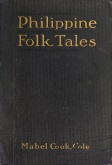Tinguian - Introduction
Filipino folktale
The dim light of stars filtered through the leafy canopy above us, and the shadowy form of our guide once more appeared at my horse’s head. It was only for an instant, however, and then we were plunged again into the inky darkness of a tropical jungle.
We had planned to reach the distant Tinguian village in the late afternoon, but had failed to reckon with the deliberateness of native carriers. It was only by urging our horses that we were able to ford the broad Abra ere the last rays of the sun dropped behind the mountains. And then, in this land of no twilights, night had settled quickly over us.
We had made our way up the mountain-side, through the thick jungle, only to find that the trail, long imperceptible to us, had escaped even the keen eyes of our guide. For several hours we wandered about, lost in the darkness.
On and on we went, through narrow paths, steep in places, and made rough and dangerous by sharp rocks as well as by those long creepers of the jungle whose thorny fingers are ever ready to seize horse or rider. Occasionally we came out of the forest, only to cross rocky mountain streams; or perhaps it was the same stream that we crossed many times. Our horses, becoming weary and uncertain of foot, grew more and more reluctant to plunge into the dark, swiftly flowing water. And our patience was nearly exhausted when we at last caught sight of dim lights in the valley below. Half an hour later we rode into Manabo.
I shall never forget that first picture. It was a weird spectacle. Coming out of the darkness, we were almost convinced that we had entered a new world. Against the blackness of the night, grass-roofed houses stood outlined in the dim light of a bonfire; and squatting around that fire, unclad save for gay blankets wrapped about their shoulders, were brown-skinned men smoking long pipes, while women bedecked with bright beads were spinning cotton. As they worked in the flickering light, they stretched their distaffs at arm’s length into the air like witches waving their wands; and with that the elfland picture was complete.
In the stillness of the night a single voice could be heard reciting some tale in a singsong tone, which was interrupted only when peals of laughter burst forth from the listeners, or when a scrawny dog rose to bark at an imaginary noise until the shouts of the men quieted him and he returned to his bed in the warm ashes. Later we learned that these were the regular social gatherings of the Tinguian, and every night during the dry season one or more of these bonfires were to be seen in the village.
After we had attained to the footing of welcome guests in these circles, we found that a good story-teller was always present, and, while the men smoked, the women spun, and the dogs slept, he entertained us with tales of heroes who knew the magic of the betel-nut, or with stories of spirits and their power over the lives of men.
The following are some of the tales heard first around the camp fire of the distant mountain village.
Philippine Folk Tales

Notes: This book features 61 folktales from the Philippines.
Author: Mabel Cook Cole
Published: 1916
Publisher: A.C. McClurg & Co., Chicago